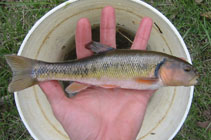| Family: |
Leuciscidae (Minnows), subfamily: Plagopterinae |
| Max. size: |
30.3 cm TL (male/unsexed); max. reported age: 8 years |
| Environment: |
demersal; freshwater |
| Distribution: |
North America: most of east USA and southeast Canada in Atlantic, Great Lakes, Hudson Bay, Mississippi, and Gulf basins as far west as Saskatchewan, Wyoming, and Brazos River in Texas, but absent from Florida and south Georgia; isolated population in the upper Pecos and Canadian River systems, New Mexico. Introduced elsewhere in USA. |
| Diagnosis: |
Dorsal soft rays (total): 8-8. Semotilus atromaculatus is distinguished by having the following characters: body barely compressed at front, compressed at caudal peduncle; mouth pointed; 47-65 scales on lateral line; dorsal fin with 8 rays; large black spot at front of dorsal fin base, black caudal spot (not distinct in large individuals); large terminal mouth reaching past front of eye. Coloration consists of gray-brown above, dark stripe along back; herringbone lines on upper side in young; dusky black stripe (darkest on young) along olive-silver side, around snout and onto upper lip; black bar along back of gill cover; and orange at dorsal base, orange lower fins, blue on side of head, pink on lower half of head and body, and 6-12 large tubercles on head in breeding males (Ref. 86798). |
| Biology: |
Inhabits rocky and sandy pools of headwaters, creeks and small rivers (Ref. 5723, 86798). Mostly found in tiny, intermittent streams. Young feed on small aquatic invertebrates while adults consume small fish, crayfish and other large invertebrates (Ref. 10294). One of the most common fishes in eastern North America (Ref. 86798). |
| IUCN Red List Status: |
Least Concern (LC); Date assessed: 01 March 2012 Ref. (130435)
|
| Threat to humans: |
harmless |
Source and more info: www.fishbase.org. For personal, classroom, and other internal use only. Not for publication.

